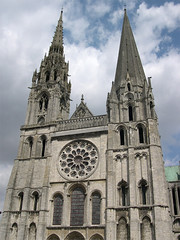We chose Alençon for a stop on the way back from the Vendée to the ferry, arriving in the mid-afternoon on Saturday.
The Basilica of Nôtre Dame, raised to this status by Pope John Paul II in recognition of its role in the life of the family of St Thérèse of Lisieux, is a strange mix of two styles. At one end the Gothic windows form a tracery along the walls of the nave; beyond this the solidity of an 18th century tower and transept (which replaced the former tower, toppled by a storm). The newer end is solid, unbreachable stone, like a fortress; the older exuberant and confident. The mixture somehow leaves a sense of change and uncertainty.
We sat outside a bar across the square from the Basilica and drank a beer, while perusing the leaflets provided by the tourist office. The English in the leaflet about the Basilica itself likewise leaves a sense of change and uncertainty; it’s once been translated well, then had extra bits added!
Inside the Basilica the side chapel dedicated to St Thérèse and her sense of peace and gentleness lies immediately opposite that of St Jeanne d’Arc, whose image is military and patriotic; two deeply contrasted derivations of the Christian life face each other, each unashamed. The information boards are clear and gently understated.
Mass is celebrated at what appears to be a wooden altar in front of the original stone one, as though the practice of the priest facing the people during Mass is still regarded as a temporary phase; the omissions and slight variations in the liturgy perhaps also indicate an uncertainty over the Roman Liturgy itself, and are even more confusing to the visitor already working in a foreign tongue.
The congregation is reasonably numerous but aging. The homily focussed on the feeding of the five thousand as a sign of the unity of bread, word and mission. One senses a contrast between the older, quieter people at Mass inside and the noisier and younger life of the square outside; but the clangour of the bells announcing finally that we were dismissed into the world to take Christ out into its carelessness brings the two into unity. If those bells did not ring out the town would not be the same, and one senses that the town knows that.
We stayed overnight at the Hotel du Dauphin, St Pierre des Nids, for which an unashamed recommendation. The room, recently redecorated, still perhaps no more than a room, but comfortable and fresh; the food is excellent and the service from the owners, Olivier and Sonia, is welcoming and cheerful. In the morning, we strolled round the village and gained the sense that there is more to do around here then we knew – we will return.
Then back to the city to visit the Martin’s House, where the parents of St Thérèse lived, and where the little flower herself was born. A smiling nun with a good grasp of English is called to show us round, and does so with a mixture of history, spirituality and personal joy which is quietly inspiring. The réalisation of the museum is very well done and brings the past alive, preserving something of the life of the family amid the shrine which has grown up alongside it. There is perhaps little of St Thérèse herself here – the house saw only some of her early childhood, though there are glimpses of her life and character – but the daily holiness of the lives of her parents stands out clearly.



